 Facebook
Facebook
 X
X
 Instagram
Instagram
 TikTok
TikTok
 Youtube
Youtube

Whenever I tell someone I’m from the South, his mind — with his mouth in hot pursuit — scurries straight to assumptions about racism, deep fried fill-in-the-blanks, Paula Deen, and Confederate flags.
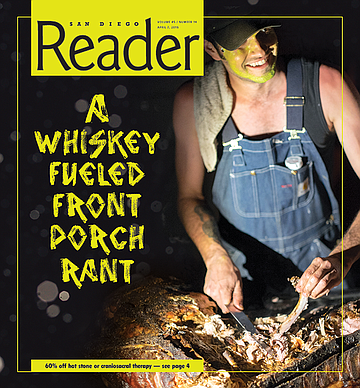
Whenever I mention to someone that I live in Tijuana, I am labeled a danger junkie with little regard for my life, obviously so coke-addled and sex-addicted that good intentions or common sense must have gotten snatched by the federales when I first ventured on down.
This condescension on what boils down to fundamental elements of my identity is ignorant and annoying, sure. But it’s also indicative of something deeper than the desperate grasping of outsiders to shape a place with their misconceptions in order to degrade it. Look here: the South and Tijuana are both so steeped in their identities that each is its own living myth. Both are so neck-deep in their histories that the past and the present thrash around trying to separate, banging into everything and turning it upside or putting it back in its right place. This does not happen everywhere.

I came to TJ two years ago with my casiesposa and Batman the dog. Our plan was to stay long enough for her to finish her fieldwork for her PhD and for me to regroup my brain and write as if it were my job. In other words, one year. In that time I wrote plenty, but I also received enough rejection letters to paper a small apartment, learned a passable Spanish riddled with grammatical landmines, and opened a Southern soul-food shack in downtown Tijuana.
Pasaje Rodriguez (between Third and Fourth on Revolución), Tijuana, BC
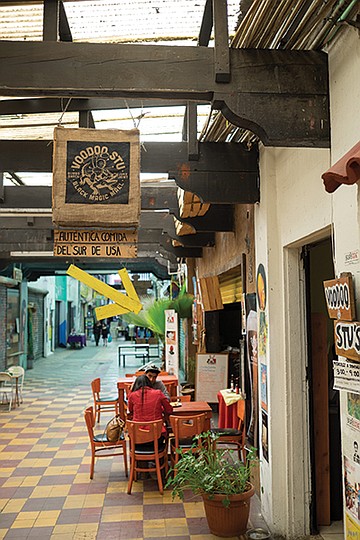
The restaurant — Voodoo Stu and Black Magic Mael’s Gumbo Shack and Juke Joint — is a product of my frustrated thumb-twiddling idleness, the persistent mosquito buzz of homesickness in my head, and the dropped anchor that would keep me from doing the easy thing of retreating back to my previous life in the despicable film industry. Voodoo Stu’s (the name admittedly a blatant bit of cultural appropriation deemed necessary to contextualize gumbo and shrimp ’n’ grits to norteños) is my shrine to the South. It’s the best tribute I can currently muster to the place that continues to make me who I am; all the good and all the bad.
“It just feels different in here than anywhere else in TJ,” my customers tell me. I can’t imagine a better compliment, even though guilt scatters like hot buckshot in my guts when I think on it. Ambassador from the land I love I may be, but I’ve also commodified that land to the best of my abilities. And to make matters worse, I’ve done this in the heart of a city infested with the same sort of buzzards of culture and snake-oil salesmen claiming they’ve got the beating heart of what makes TJ TJ gripped in their entrepreneurial fists. And even better? They’ll sell it to you. They will sell you this discovered authenticity.
Based on my market research prior to opening — if shoveling street tacos and pouring caguamas down my facehole in TJ dives counts as research — I knew that authenticity was the most valuable asset in my Southern toolbelt. On both sides of the border. You can’t deny it, San Diegans: I’ve seen you on your TJ adventures. You’ve walked past my doors, taken a look at my skin (darker than my tijuanense casiesposa’s courtesy of generations of Georgia sunshine baking my barefoot ancestors olive), made the assumption that I was a Mexican playing at Southern food, and scoffed or said “yeah, right” in an English you assumed I wouldn’t understand.
Once the truth of my roots emerge and we wade hand-in-hand through the onslaught of paint-by-numbers Southern stereotypes, you often and understandably might still opt for tacos, but your perception of the restaurant drastically changes. You believe in it, and it feels more relevant somehow.
This “absence of authenticity as non-starter” is enormously problematic. It’s more than just another byproduct of the farm-to-table, slow-food, organic, free-range, handcrafted, handpicked, local, heirloom, small-batch, artisanal, cough, bullshit, cough, millennial rebuttal of everything the baby boomers worked so long and hard to streamline and homogenize.
In essence, if something is authentic, it is adopted by modern trends as the Platonic Pure and a rejection of the consumerist commercialized house that capitalism built. Except that it isn’t! Most Southerners who were more or less adults by the 1950s get their tickle boxes right turned over with the “return to the way things were” obsession of the current generations. Do you know why? It’s because that’s how they grew up! They ate what they could grow, canned what they needed to get them through the winter, ate meat when — and only when — it came time to wring a chicken’s neck or whack a pig with the blunt edge of ax. And then they used the feathers to make a pillow and the pork fat to cook their biscuits. Nothing got wasted because “waste not want not.”
And life was good, but dammit if it wasn’t hard.
You’ll have to forgive me as I dance around the point here with what’s devolving into a whiskey-fueled front-porch rant, but the very fact that the above paragraph reads like the label on a jar of six-dollar organic green beans says it all. Realness is for sale. Simplicity is for sale. The old ways are for sale. Authentic grits ground by a stone turned by a centrifugal mule can be bought (if rarely appreciated) in all four corners of the country. But the ghost of the dirt-smudged, overall-clad sharecropper straight out of a Walker Evans portrait playing the unwilling mascot of ancestral authenticity? He couldn’t afford a 20-ounce bag after an entire year of back-breaking work.
...Everybody seems to more or less agree that Tijuana is real. At the very least, all agree on the idea that a real Tijuana exists somewhere within the spiraling, twinkling, dusty sprawl. Ask any local and he or she can wax borderline eternal about those places deserving of a true tijuanense’s patronage. The same local will have just as much hot air reserved, mind you, for the spots better suited for hacking to pieces and feeding to the beloved zonkeys — those bars, restaurants, and clubs deemed tourist fodder and scene lampreys, capitalizing on the perceived trends and gimmicks in pursuit of nothing more than paper money to rub together. Not to say there is anything inherently wrong with the latter approach, but tijuanenses possess a preternatural ability to discern between the two with nothing more than a half-interested sideways glance; and you better believe it when I tell you that that’s the most they will ever interact with the place.
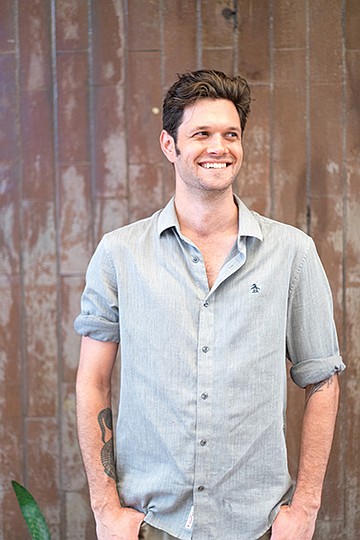
Articulating the fine line that separates the soul of TJ from the soulless places hellbent on selling the soul of TJ is not unlike trying to catch an uppity chicken in a big yard; in other words, it’s a safe bet that you’re going to slink away hungry with a fistful of feathers. Yet somehow, for us gabachos, I can’t help but think it’s this elusiveness that keeps us coming back again and again to slacken our jaws and swivel our heads at the sights and smells and feel of a place so self-possessed that its existence is the only marketing strategy it will ever need (this is what the Tijuana tourism board manages to get so wrong over and over again).
As a white devil, it feels empowering to make the jackass assumptions that lead me to believe that I understand this concept. It’s a comfort to know that I and those like me will always be welcome here, but no matter how much Spanish we learn, how many local-approved businesses we frequent or open, how many layers of cultural camouflage we shroud ourselves in to blend into the noise, we can never and will never belong. And this is a beautiful thing. Some things should forever remain out of reach.
Please forgive my romanticizing; it’s a tendency symptomatic of my Southern heritage that victimizes everything and everyone within eye-shot and earshot. I know that the allure of TJ is a double-headed snake. I recognize that there is a part of Tijuana that will always and forever exist for the red-light tourists of young dudes sporting whatever passes as the current popped collar and old men with uncombed hair who wear sunglasses at night in a way that’s even worse than Corey Hart made it sound. But this is a phenomenon born out of nothing more than economics — granted a particular strain of economics that’s straddling a border and barking barely intelligible cultural directives through a megaphone — but economics just the same, and economics is boring, right? Even when it means that every time I rub shoulders with a bright-eyed and bushy-tailed, fresh-off-the-boat, first-time-in-Tijuana, American 20-something, it’s only a matter of time before they ask me if I know where they can “score some coke.” It’s boring even though it fuels an industry that enslaves women and children through kidnapping, intimidation, and unimaginable violence; justified by these lonely male border-crossing scavengers who think the scraps of paper with American presidents on them in their pockets makes them invincible and unaccountable to moral scrutiny. Invincible of course, until some crooked Mexican cop or street vampire manages to swindle you or rob you and then it’s spitting on the sidewalk and cursing this damn wasteland of a town full of heathens. But what can you really expect? Your consequence-free, south-of-the-border playground you and your spending money demanded is built and bought and paid for on the exploitation and desperation of the weak, and if somebody manages to peel away from you that which you thought was yours in a place like that, well, what’s that make you?
But the thing is — and this is the part where the plight of the tijuanense and the plight of yours truly are hitched together in mutual understanding — Tijuana is about so much more than that! If you’re asking where you can score coke, you’re asking the entirely wrong question. Ask where you can score an asada taco that will refuse to be anything but the best taco in the world while you’re eating it. (Locals can never agree on where in TJ this taco is, but everyone at least knows that if it’s anywhere, it’s here in TJ.) Ask where you can look down a street and see the past 60 years splayed out in the layers of signs, buildings, graffiti, decay, and rejuvenation. Ask about aguachiles. Ask about craft beer. Ask about music. Ask about day-hikes and record shops and business startups and what us gabachos call the American dream, hiding down here where it belongs, in a city that’s raw and full of actualized possibility.
I grew up hanging my hat on the American dream — work hard, do good, and success is inevitable. The older I get, the more I realize this mantra is not much more than a ploy to get me to buy name-brand cereal and to never stop marching straight ahead toward my final destination as a cog in a machine that will never belong to anyone. Calm down — I’m not saying it’s a lie. All I’m saying is that I’m a white guy with an education (read: privileged as hell) and bringing the dream home to my front door has always been more about luck than anything. I’m not rich enough for it to be about anything else.
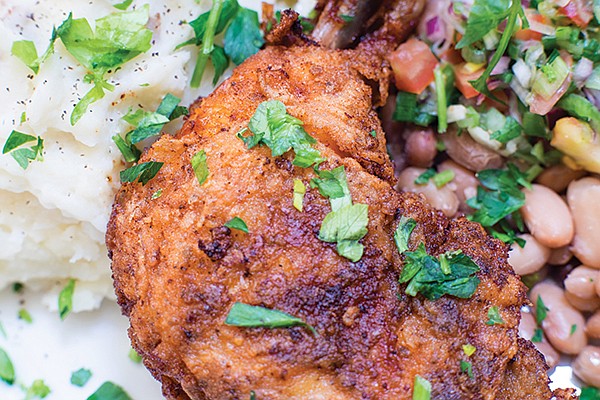
But in Tijuana? If you’re resourceful and creative and eager to work hard, this city will welcome you into the fold and hoist you onto its shoulders. My social circle is peppered with folks from all sorts of far-flung corners of Mexico, and they all swear by the warm welcome and prosperity they received in this town that will let you peddle tamales out of the trunk of a car (as long as they’re good) or roll a cardboard box full of eggrolls through the downtown bar and venue circuit hollering “chun qun!” or paint a giant Frida mural on the side of your house and turn it into a café or, hell, even open a Southern soul-food shack that doesn’t quite seem possible in any other place in Mexico I’ve ever visited.
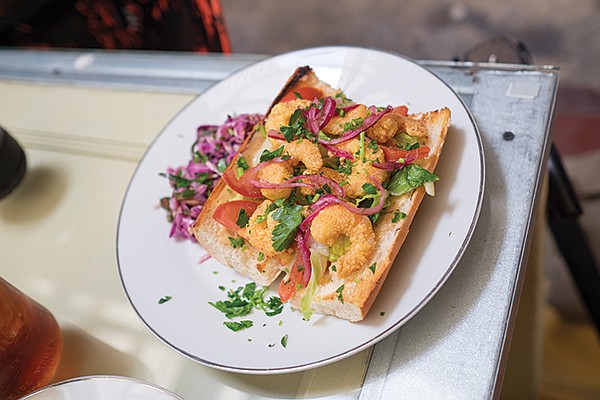
Let’s be clear here. This is not a saber rattle meant for the adventurous San Diegans sporting what they fancy an entrepreneurial spirit to transplant the chalkboard-and-pallet-furniture inbred lovechild of shabby chic and Pier 1 to Tijuana. Nobody wants that here. Nobody wants to pay too much money for housemade bitters and soggy fries, no matter what kind of reclaimed material the light hanging over the table is made of. Keep it on the other side where it belongs. No, what I’m still prattling on about is that intangible spirit of a place that has always existed for others. A town that sprouted like kudzu out of a few ranches when and only when rich Californians needed to keep getting their jollies in style, 18th Amendment be damned. A town championed by its hippest residents as a place that is developing its cultural playgrounds and arts and identity for nobody but itself for the first time in its history. And this may be true. I hope it’s true. But I think the spirit of a place that was founded on welcoming those from elsewhere is a tricky thing to shake. Then again, if there’s anywhere I’ve ever been that can figure out how to negotiate the incongruous selfishness and selflessness of place, it’s Tijuana.


Whenever I tell someone I’m from the South, his mind — with his mouth in hot pursuit — scurries straight to assumptions about racism, deep fried fill-in-the-blanks, Paula Deen, and Confederate flags.

Whenever I mention to someone that I live in Tijuana, I am labeled a danger junkie with little regard for my life, obviously so coke-addled and sex-addicted that good intentions or common sense must have gotten snatched by the federales when I first ventured on down.
This condescension on what boils down to fundamental elements of my identity is ignorant and annoying, sure. But it’s also indicative of something deeper than the desperate grasping of outsiders to shape a place with their misconceptions in order to degrade it. Look here: the South and Tijuana are both so steeped in their identities that each is its own living myth. Both are so neck-deep in their histories that the past and the present thrash around trying to separate, banging into everything and turning it upside or putting it back in its right place. This does not happen everywhere.

I came to TJ two years ago with my casiesposa and Batman the dog. Our plan was to stay long enough for her to finish her fieldwork for her PhD and for me to regroup my brain and write as if it were my job. In other words, one year. In that time I wrote plenty, but I also received enough rejection letters to paper a small apartment, learned a passable Spanish riddled with grammatical landmines, and opened a Southern soul-food shack in downtown Tijuana.
Pasaje Rodriguez (between Third and Fourth on Revolución), Tijuana, BC

The restaurant — Voodoo Stu and Black Magic Mael’s Gumbo Shack and Juke Joint — is a product of my frustrated thumb-twiddling idleness, the persistent mosquito buzz of homesickness in my head, and the dropped anchor that would keep me from doing the easy thing of retreating back to my previous life in the despicable film industry. Voodoo Stu’s (the name admittedly a blatant bit of cultural appropriation deemed necessary to contextualize gumbo and shrimp ’n’ grits to norteños) is my shrine to the South. It’s the best tribute I can currently muster to the place that continues to make me who I am; all the good and all the bad.
“It just feels different in here than anywhere else in TJ,” my customers tell me. I can’t imagine a better compliment, even though guilt scatters like hot buckshot in my guts when I think on it. Ambassador from the land I love I may be, but I’ve also commodified that land to the best of my abilities. And to make matters worse, I’ve done this in the heart of a city infested with the same sort of buzzards of culture and snake-oil salesmen claiming they’ve got the beating heart of what makes TJ TJ gripped in their entrepreneurial fists. And even better? They’ll sell it to you. They will sell you this discovered authenticity.
Based on my market research prior to opening — if shoveling street tacos and pouring caguamas down my facehole in TJ dives counts as research — I knew that authenticity was the most valuable asset in my Southern toolbelt. On both sides of the border. You can’t deny it, San Diegans: I’ve seen you on your TJ adventures. You’ve walked past my doors, taken a look at my skin (darker than my tijuanense casiesposa’s courtesy of generations of Georgia sunshine baking my barefoot ancestors olive), made the assumption that I was a Mexican playing at Southern food, and scoffed or said “yeah, right” in an English you assumed I wouldn’t understand.
Once the truth of my roots emerge and we wade hand-in-hand through the onslaught of paint-by-numbers Southern stereotypes, you often and understandably might still opt for tacos, but your perception of the restaurant drastically changes. You believe in it, and it feels more relevant somehow.
This “absence of authenticity as non-starter” is enormously problematic. It’s more than just another byproduct of the farm-to-table, slow-food, organic, free-range, handcrafted, handpicked, local, heirloom, small-batch, artisanal, cough, bullshit, cough, millennial rebuttal of everything the baby boomers worked so long and hard to streamline and homogenize.
In essence, if something is authentic, it is adopted by modern trends as the Platonic Pure and a rejection of the consumerist commercialized house that capitalism built. Except that it isn’t! Most Southerners who were more or less adults by the 1950s get their tickle boxes right turned over with the “return to the way things were” obsession of the current generations. Do you know why? It’s because that’s how they grew up! They ate what they could grow, canned what they needed to get them through the winter, ate meat when — and only when — it came time to wring a chicken’s neck or whack a pig with the blunt edge of ax. And then they used the feathers to make a pillow and the pork fat to cook their biscuits. Nothing got wasted because “waste not want not.”
And life was good, but dammit if it wasn’t hard.
You’ll have to forgive me as I dance around the point here with what’s devolving into a whiskey-fueled front-porch rant, but the very fact that the above paragraph reads like the label on a jar of six-dollar organic green beans says it all. Realness is for sale. Simplicity is for sale. The old ways are for sale. Authentic grits ground by a stone turned by a centrifugal mule can be bought (if rarely appreciated) in all four corners of the country. But the ghost of the dirt-smudged, overall-clad sharecropper straight out of a Walker Evans portrait playing the unwilling mascot of ancestral authenticity? He couldn’t afford a 20-ounce bag after an entire year of back-breaking work.
...Everybody seems to more or less agree that Tijuana is real. At the very least, all agree on the idea that a real Tijuana exists somewhere within the spiraling, twinkling, dusty sprawl. Ask any local and he or she can wax borderline eternal about those places deserving of a true tijuanense’s patronage. The same local will have just as much hot air reserved, mind you, for the spots better suited for hacking to pieces and feeding to the beloved zonkeys — those bars, restaurants, and clubs deemed tourist fodder and scene lampreys, capitalizing on the perceived trends and gimmicks in pursuit of nothing more than paper money to rub together. Not to say there is anything inherently wrong with the latter approach, but tijuanenses possess a preternatural ability to discern between the two with nothing more than a half-interested sideways glance; and you better believe it when I tell you that that’s the most they will ever interact with the place.

Articulating the fine line that separates the soul of TJ from the soulless places hellbent on selling the soul of TJ is not unlike trying to catch an uppity chicken in a big yard; in other words, it’s a safe bet that you’re going to slink away hungry with a fistful of feathers. Yet somehow, for us gabachos, I can’t help but think it’s this elusiveness that keeps us coming back again and again to slacken our jaws and swivel our heads at the sights and smells and feel of a place so self-possessed that its existence is the only marketing strategy it will ever need (this is what the Tijuana tourism board manages to get so wrong over and over again).
As a white devil, it feels empowering to make the jackass assumptions that lead me to believe that I understand this concept. It’s a comfort to know that I and those like me will always be welcome here, but no matter how much Spanish we learn, how many local-approved businesses we frequent or open, how many layers of cultural camouflage we shroud ourselves in to blend into the noise, we can never and will never belong. And this is a beautiful thing. Some things should forever remain out of reach.
Please forgive my romanticizing; it’s a tendency symptomatic of my Southern heritage that victimizes everything and everyone within eye-shot and earshot. I know that the allure of TJ is a double-headed snake. I recognize that there is a part of Tijuana that will always and forever exist for the red-light tourists of young dudes sporting whatever passes as the current popped collar and old men with uncombed hair who wear sunglasses at night in a way that’s even worse than Corey Hart made it sound. But this is a phenomenon born out of nothing more than economics — granted a particular strain of economics that’s straddling a border and barking barely intelligible cultural directives through a megaphone — but economics just the same, and economics is boring, right? Even when it means that every time I rub shoulders with a bright-eyed and bushy-tailed, fresh-off-the-boat, first-time-in-Tijuana, American 20-something, it’s only a matter of time before they ask me if I know where they can “score some coke.” It’s boring even though it fuels an industry that enslaves women and children through kidnapping, intimidation, and unimaginable violence; justified by these lonely male border-crossing scavengers who think the scraps of paper with American presidents on them in their pockets makes them invincible and unaccountable to moral scrutiny. Invincible of course, until some crooked Mexican cop or street vampire manages to swindle you or rob you and then it’s spitting on the sidewalk and cursing this damn wasteland of a town full of heathens. But what can you really expect? Your consequence-free, south-of-the-border playground you and your spending money demanded is built and bought and paid for on the exploitation and desperation of the weak, and if somebody manages to peel away from you that which you thought was yours in a place like that, well, what’s that make you?
But the thing is — and this is the part where the plight of the tijuanense and the plight of yours truly are hitched together in mutual understanding — Tijuana is about so much more than that! If you’re asking where you can score coke, you’re asking the entirely wrong question. Ask where you can score an asada taco that will refuse to be anything but the best taco in the world while you’re eating it. (Locals can never agree on where in TJ this taco is, but everyone at least knows that if it’s anywhere, it’s here in TJ.) Ask where you can look down a street and see the past 60 years splayed out in the layers of signs, buildings, graffiti, decay, and rejuvenation. Ask about aguachiles. Ask about craft beer. Ask about music. Ask about day-hikes and record shops and business startups and what us gabachos call the American dream, hiding down here where it belongs, in a city that’s raw and full of actualized possibility.
I grew up hanging my hat on the American dream — work hard, do good, and success is inevitable. The older I get, the more I realize this mantra is not much more than a ploy to get me to buy name-brand cereal and to never stop marching straight ahead toward my final destination as a cog in a machine that will never belong to anyone. Calm down — I’m not saying it’s a lie. All I’m saying is that I’m a white guy with an education (read: privileged as hell) and bringing the dream home to my front door has always been more about luck than anything. I’m not rich enough for it to be about anything else.

But in Tijuana? If you’re resourceful and creative and eager to work hard, this city will welcome you into the fold and hoist you onto its shoulders. My social circle is peppered with folks from all sorts of far-flung corners of Mexico, and they all swear by the warm welcome and prosperity they received in this town that will let you peddle tamales out of the trunk of a car (as long as they’re good) or roll a cardboard box full of eggrolls through the downtown bar and venue circuit hollering “chun qun!” or paint a giant Frida mural on the side of your house and turn it into a café or, hell, even open a Southern soul-food shack that doesn’t quite seem possible in any other place in Mexico I’ve ever visited.

Let’s be clear here. This is not a saber rattle meant for the adventurous San Diegans sporting what they fancy an entrepreneurial spirit to transplant the chalkboard-and-pallet-furniture inbred lovechild of shabby chic and Pier 1 to Tijuana. Nobody wants that here. Nobody wants to pay too much money for housemade bitters and soggy fries, no matter what kind of reclaimed material the light hanging over the table is made of. Keep it on the other side where it belongs. No, what I’m still prattling on about is that intangible spirit of a place that has always existed for others. A town that sprouted like kudzu out of a few ranches when and only when rich Californians needed to keep getting their jollies in style, 18th Amendment be damned. A town championed by its hippest residents as a place that is developing its cultural playgrounds and arts and identity for nobody but itself for the first time in its history. And this may be true. I hope it’s true. But I think the spirit of a place that was founded on welcoming those from elsewhere is a tricky thing to shake. Then again, if there’s anywhere I’ve ever been that can figure out how to negotiate the incongruous selfishness and selflessness of place, it’s Tijuana.
Comments